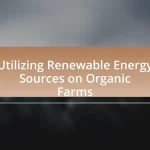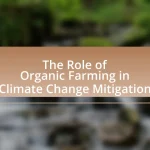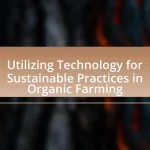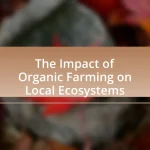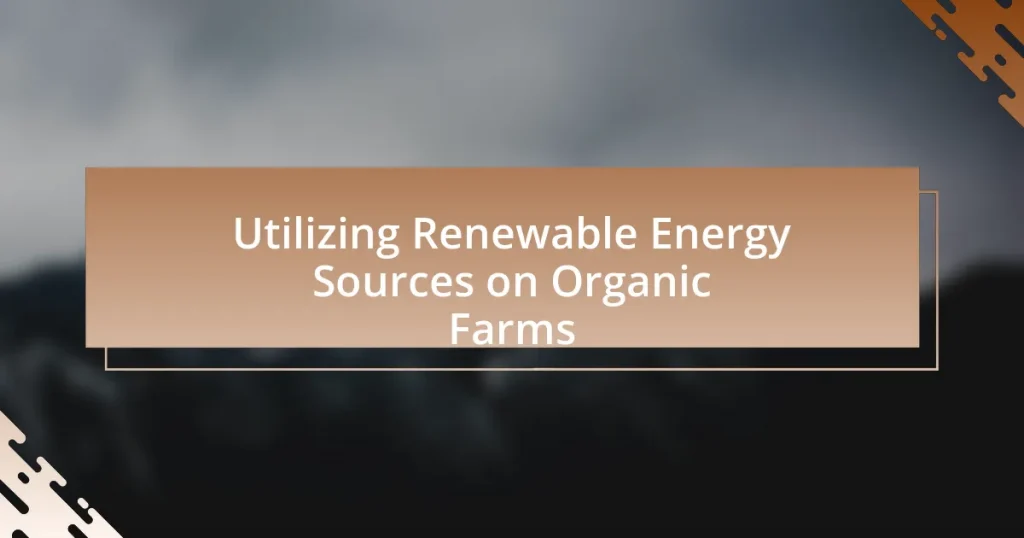Renewable energy sources, including solar, wind, hydro, and biomass, play a crucial role in enhancing the sustainability of organic farms by reducing reliance on fossil fuels and lowering greenhouse gas emissions. This article explores the differences between renewable and traditional energy sources, the types commonly used in organic farming, and the environmental benefits associated with their adoption. It also addresses the challenges organic farmers face in implementing renewable energy solutions, such as financial barriers and technical issues, while providing insights into best practices for integrating these technologies into farm operations. Additionally, the article highlights the importance of community education and available resources to support farmers in transitioning to renewable energy.
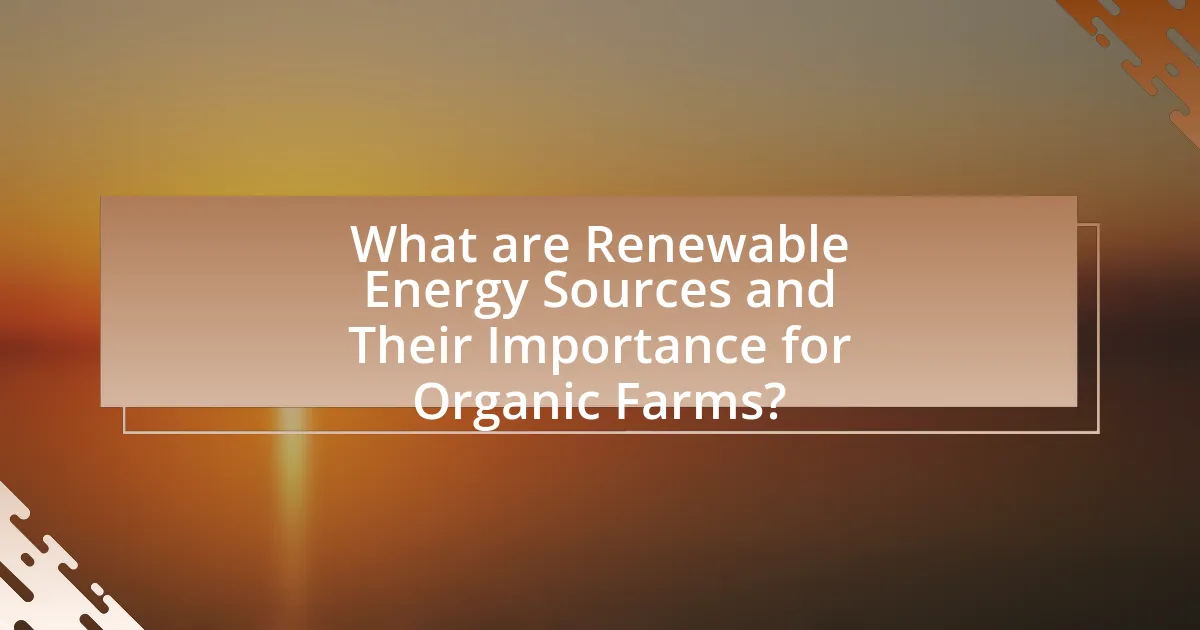
What are Renewable Energy Sources and Their Importance for Organic Farms?
Renewable energy sources are energy forms that are replenished naturally, including solar, wind, hydro, and biomass energy. Their importance for organic farms lies in their ability to reduce reliance on fossil fuels, lower greenhouse gas emissions, and promote sustainable agricultural practices. For instance, solar panels can provide electricity for irrigation systems, while wind turbines can generate power for farm operations, enhancing energy independence. Studies indicate that integrating renewable energy can lead to cost savings and improved environmental outcomes, making organic farms more resilient and sustainable in the long term.
How do renewable energy sources differ from traditional energy sources?
Renewable energy sources differ from traditional energy sources primarily in their sustainability and environmental impact. Renewable energy, such as solar, wind, and hydroelectric power, is derived from natural processes that are replenished constantly, whereas traditional energy sources, like coal, oil, and natural gas, are finite and contribute to greenhouse gas emissions and pollution. For instance, the International Energy Agency reported that renewable energy sources can significantly reduce carbon emissions, with solar energy alone having the potential to cut global CO2 emissions by up to 4 billion tons annually by 2040. This distinction highlights the long-term viability and ecological benefits of renewable energy compared to the detrimental effects of traditional energy sources.
What types of renewable energy sources are commonly used on organic farms?
Organic farms commonly utilize solar energy, wind energy, and biomass as renewable energy sources. Solar energy is harnessed through photovoltaic panels to power farm operations, while wind energy is captured using turbines to generate electricity. Biomass, derived from organic waste, is used for heating and energy production. These renewable sources help reduce reliance on fossil fuels and lower greenhouse gas emissions, aligning with the sustainable practices of organic farming.
Why is it crucial for organic farms to adopt renewable energy sources?
It is crucial for organic farms to adopt renewable energy sources to enhance sustainability and reduce their carbon footprint. By utilizing renewable energy, such as solar or wind power, organic farms can decrease reliance on fossil fuels, which contributes to greenhouse gas emissions. For instance, a study by the National Renewable Energy Laboratory found that transitioning to renewable energy can reduce agricultural emissions by up to 30%. This shift not only aligns with the principles of organic farming, which emphasize environmental stewardship, but also can lead to cost savings in the long term through reduced energy expenses.
What are the environmental benefits of utilizing renewable energy on organic farms?
Utilizing renewable energy on organic farms significantly reduces greenhouse gas emissions. By replacing fossil fuels with solar, wind, or biomass energy, organic farms can lower their carbon footprint, contributing to climate change mitigation. For instance, a study by the National Renewable Energy Laboratory found that solar energy systems can reduce emissions by up to 90% compared to conventional energy sources. Additionally, renewable energy promotes biodiversity by minimizing pollution and habitat destruction associated with fossil fuel extraction and use. This shift supports sustainable agricultural practices, enhancing soil health and water conservation, which are critical for organic farming.
How does renewable energy usage reduce carbon footprints on farms?
Renewable energy usage reduces carbon footprints on farms by replacing fossil fuels with cleaner energy sources, thereby decreasing greenhouse gas emissions. For instance, solar panels and wind turbines can power farm operations, significantly lowering reliance on diesel generators and other carbon-intensive energy sources. According to a study by the National Renewable Energy Laboratory, farms that adopt renewable energy technologies can reduce their carbon emissions by up to 80%. This transition not only mitigates climate change impacts but also enhances energy independence for farmers.
What impact does renewable energy have on soil health and biodiversity?
Renewable energy positively impacts soil health and biodiversity by promoting sustainable agricultural practices. The use of renewable energy sources, such as solar and wind, reduces reliance on fossil fuels, which can lead to soil degradation and pollution. For instance, studies have shown that integrating solar panels into agricultural landscapes can enhance soil moisture retention and reduce erosion, thereby improving soil health. Additionally, renewable energy systems can support biodiversity by providing habitats for various species, as seen in agrovoltaic systems where crops and solar panels coexist, fostering a diverse ecosystem. Research indicates that these practices can lead to increased species richness and abundance, contributing to overall ecological balance.
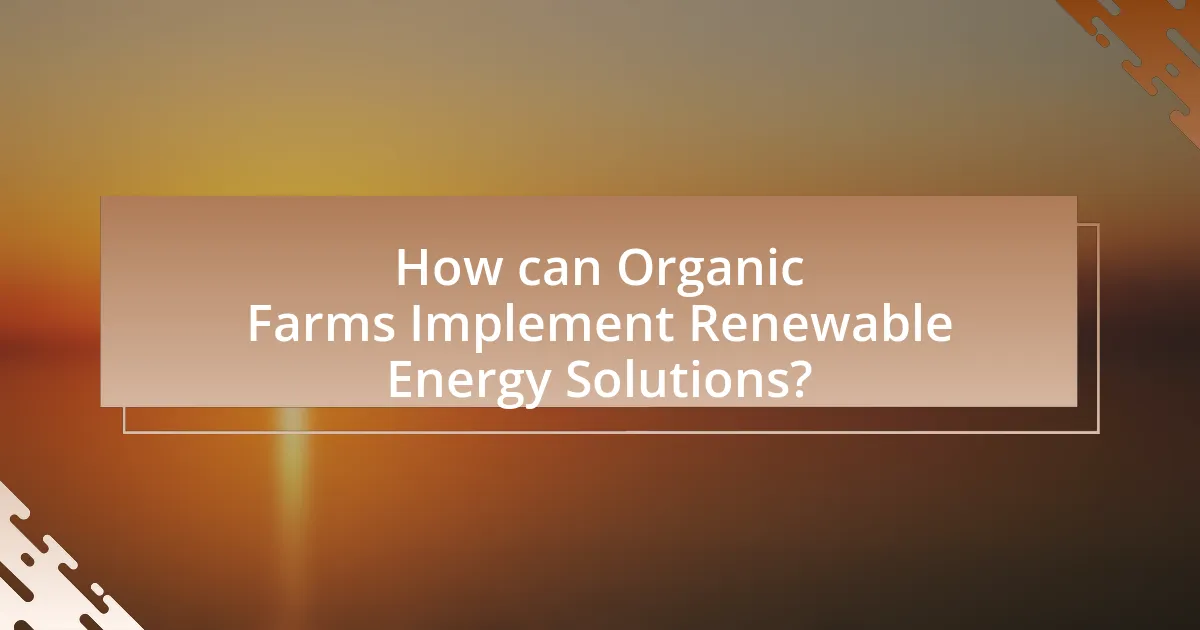
How can Organic Farms Implement Renewable Energy Solutions?
Organic farms can implement renewable energy solutions by integrating solar panels, wind turbines, and biomass systems into their operations. Solar panels can be installed on rooftops or land to harness sunlight, providing a sustainable energy source that reduces reliance on fossil fuels. Wind turbines can be utilized in areas with sufficient wind resources to generate electricity, while biomass systems can convert organic waste into energy, promoting a circular economy. According to the U.S. Department of Agriculture, renewable energy systems can significantly lower energy costs and enhance farm sustainability, making them a viable option for organic farms seeking to reduce their carbon footprint and improve energy efficiency.
What steps should organic farmers take to assess their energy needs?
Organic farmers should conduct an energy audit to assess their energy needs. This involves evaluating current energy consumption patterns, identifying energy sources, and analyzing energy usage across various farm operations. Farmers can gather data on electricity, fuel, and water usage, and then calculate the total energy demand by considering peak usage times and seasonal variations. Additionally, they should assess the efficiency of existing equipment and explore potential energy-saving measures. This systematic approach allows farmers to pinpoint areas for improvement and determine the feasibility of integrating renewable energy sources, such as solar or wind power, into their operations.
How can farmers evaluate the feasibility of different renewable energy sources?
Farmers can evaluate the feasibility of different renewable energy sources by conducting a comprehensive analysis that includes assessing resource availability, economic viability, and environmental impact. This involves measuring local wind speeds for wind energy potential, analyzing solar radiation data for solar energy, and evaluating biomass availability for bioenergy. Economic assessments should include initial investment costs, operational expenses, and potential savings or revenue from energy production. Additionally, farmers should consider government incentives and subsidies that may affect financial feasibility. Environmental impact assessments can help determine how each energy source aligns with sustainable farming practices. For instance, a study by the National Renewable Energy Laboratory indicates that solar energy can reduce energy costs by up to 75% for agricultural operations, demonstrating its economic viability.
What factors should be considered when selecting renewable energy technologies?
When selecting renewable energy technologies, factors such as resource availability, cost-effectiveness, scalability, environmental impact, and regulatory compliance must be considered. Resource availability refers to the local climate and geography, which determine the feasibility of technologies like solar, wind, or biomass. Cost-effectiveness involves analyzing initial investment, maintenance costs, and potential savings over time. Scalability assesses whether the technology can be expanded or adapted to meet future energy needs. Environmental impact evaluates how the technology affects local ecosystems and biodiversity. Regulatory compliance ensures adherence to local laws and incentives that may influence technology choice. These factors collectively guide informed decisions in the context of utilizing renewable energy sources on organic farms.
What are the common renewable energy technologies used in organic farming?
Common renewable energy technologies used in organic farming include solar energy systems, wind turbines, and biomass energy. Solar energy systems, such as photovoltaic panels, convert sunlight into electricity, providing a sustainable power source for irrigation and other farm operations. Wind turbines harness wind energy to generate electricity, which can be used to power equipment and facilities on the farm. Biomass energy involves using organic materials, such as crop residues and animal waste, to produce energy through processes like anaerobic digestion or combustion. These technologies not only reduce reliance on fossil fuels but also contribute to the overall sustainability of organic farming practices.
How does solar energy work for organic farms?
Solar energy works for organic farms by converting sunlight into electricity through photovoltaic cells, which can power various farm operations. This renewable energy source reduces reliance on fossil fuels, lowers operational costs, and minimizes carbon emissions. For instance, a study by the National Renewable Energy Laboratory found that solar installations can significantly decrease energy expenses for agricultural operations, enhancing sustainability and profitability. Additionally, solar energy can be used to power irrigation systems, greenhouses, and equipment, thereby improving efficiency and productivity on organic farms.
What role does wind energy play in sustainable farming practices?
Wind energy plays a crucial role in sustainable farming practices by providing a renewable source of electricity that reduces reliance on fossil fuels. This energy can power farm operations, such as irrigation systems, greenhouses, and equipment, leading to lower operational costs and reduced greenhouse gas emissions. According to the U.S. Department of Energy, wind energy can significantly decrease energy expenses for farmers, with some farms saving up to 50% on energy costs by utilizing wind turbines. Additionally, integrating wind energy into farming practices supports the overall goal of sustainability by promoting energy independence and reducing the carbon footprint associated with agricultural activities.
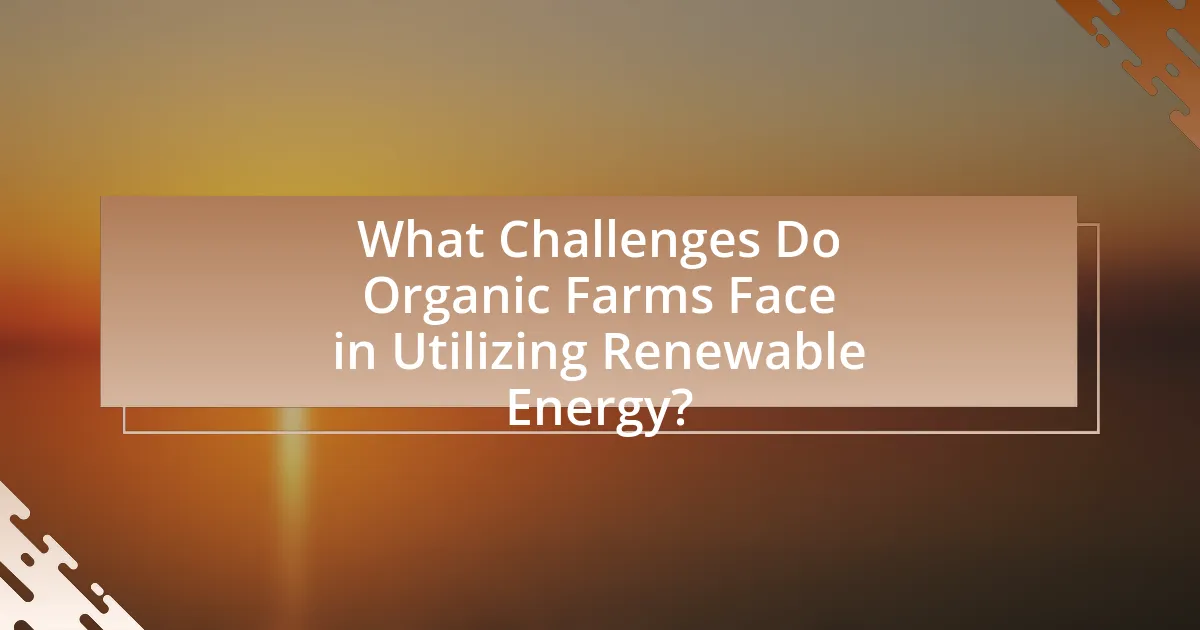
What Challenges Do Organic Farms Face in Utilizing Renewable Energy?
Organic farms face several challenges in utilizing renewable energy, primarily due to high initial costs, limited access to technology, and regulatory hurdles. The high upfront investment required for renewable energy systems, such as solar panels or wind turbines, can be prohibitive for many organic farmers, especially those operating on tight budgets. Additionally, access to advanced renewable energy technologies may be limited in rural areas where many organic farms are located, making it difficult to implement these solutions effectively. Regulatory challenges, including complex permitting processes and inconsistent policies regarding renewable energy incentives, further complicate the adoption of renewable energy on organic farms. These factors collectively hinder the transition to sustainable energy practices in the organic farming sector.
What are the financial barriers to adopting renewable energy on organic farms?
The financial barriers to adopting renewable energy on organic farms include high initial capital costs, limited access to financing, and uncertain return on investment. High initial capital costs can deter farmers from investing in renewable technologies, as systems like solar panels or wind turbines require significant upfront expenditures. Limited access to financing options, particularly for small-scale organic farmers, exacerbates this issue, as traditional lenders may view renewable energy projects as risky investments. Additionally, the uncertain return on investment stems from fluctuating energy prices and varying incentives, making it difficult for farmers to predict the long-term financial benefits of transitioning to renewable energy sources.
How can farmers access funding or incentives for renewable energy projects?
Farmers can access funding or incentives for renewable energy projects through government programs, grants, and financial institutions that support sustainable agriculture. For instance, the U.S. Department of Agriculture (USDA) offers the Rural Energy for America Program (REAP), which provides grants and loan guarantees for renewable energy systems. Additionally, state-level initiatives often include tax credits and rebates for solar or wind energy installations. According to the USDA, over $1 billion has been allocated to support renewable energy projects in rural areas, demonstrating the significant financial resources available to farmers pursuing these initiatives.
What are the long-term cost benefits of investing in renewable energy?
Investing in renewable energy leads to significant long-term cost benefits, primarily through reduced energy expenses and increased energy independence. Over time, renewable energy sources, such as solar and wind, have lower operational costs compared to fossil fuels, as they do not require fuel purchases and have minimal maintenance costs. For instance, the U.S. Department of Energy reported that the levelized cost of electricity from solar has dropped by 89% since 2009, making it one of the most affordable energy sources available. Additionally, renewable energy investments can qualify for tax incentives and grants, further lowering initial costs. By decreasing reliance on volatile fossil fuel markets, organic farms can stabilize their energy expenses, leading to predictable budgeting and enhanced financial sustainability.
What technical challenges might organic farmers encounter?
Organic farmers may encounter several technical challenges, including the integration of renewable energy systems, managing energy efficiency, and ensuring compliance with organic standards. The installation of renewable energy sources, such as solar panels or wind turbines, can be complex due to the need for specialized knowledge and infrastructure. Additionally, organic farmers must optimize energy use to reduce costs while maintaining sustainable practices, which can require advanced technology and monitoring systems. Compliance with organic certification standards can also pose challenges, as farmers must ensure that energy systems do not introduce prohibited substances or practices. These challenges are supported by studies indicating that the transition to renewable energy in agriculture often requires significant investment and technical expertise, which can be barriers for many organic farmers.
How can farmers overcome installation and maintenance issues with renewable energy systems?
Farmers can overcome installation and maintenance issues with renewable energy systems by engaging with specialized contractors and utilizing training programs. Specialized contractors possess the expertise to ensure proper installation, which minimizes future maintenance challenges. Additionally, training programs can equip farmers with the necessary skills to perform routine maintenance and troubleshooting, thereby reducing reliance on external services. Research indicates that farms that invest in training for renewable energy system maintenance experience a 30% reduction in operational downtime, demonstrating the effectiveness of this approach.
What training or resources are available for farmers to learn about renewable energy technologies?
Farmers can access various training programs and resources to learn about renewable energy technologies, including workshops, online courses, and government-sponsored initiatives. Organizations such as the USDA offer resources like the Rural Energy for America Program (REAP), which provides grants and technical assistance for renewable energy projects. Additionally, universities and agricultural extension services often conduct educational programs focused on solar, wind, and bioenergy technologies, equipping farmers with practical knowledge and skills. These resources are designed to help farmers implement renewable energy solutions effectively, contributing to sustainable farming practices.
What are the best practices for integrating renewable energy into organic farming?
The best practices for integrating renewable energy into organic farming include utilizing solar panels, wind turbines, and biomass systems to generate clean energy for farm operations. Solar panels can be installed on rooftops or in open fields to harness sunlight, providing electricity for irrigation systems, greenhouses, and equipment. Wind turbines can be strategically placed to capture wind energy, which can supplement power needs, especially in rural areas with consistent wind patterns. Biomass systems can convert organic waste from farming activities into energy, reducing waste and providing a sustainable energy source.
Research indicates that farms using renewable energy sources can reduce operational costs by up to 50% over time, as reported by the U.S. Department of Agriculture. Additionally, integrating these practices aligns with organic farming principles by minimizing environmental impact and promoting sustainability.
How can farmers effectively monitor and optimize their energy usage?
Farmers can effectively monitor and optimize their energy usage by implementing energy management systems that track consumption patterns and identify inefficiencies. These systems utilize smart meters and IoT devices to provide real-time data on energy usage, enabling farmers to make informed decisions about energy consumption. For instance, a study by the U.S. Department of Agriculture found that farms using energy management systems reduced energy costs by up to 20% through better monitoring and optimization practices. Additionally, integrating renewable energy sources, such as solar panels, can further enhance energy efficiency and sustainability on organic farms.
What strategies can be employed to educate the community about renewable energy benefits?
To educate the community about renewable energy benefits, strategies such as workshops, informational campaigns, and partnerships with local organizations can be employed. Workshops can provide hands-on experiences and demonstrations of renewable technologies, allowing participants to see the benefits firsthand. Informational campaigns utilizing social media, flyers, and community events can raise awareness about the environmental and economic advantages of renewable energy. Collaborating with local organizations, such as schools and environmental groups, can amplify outreach efforts and foster community engagement. Research indicates that communities engaged in educational initiatives about renewable energy show increased adoption rates, highlighting the effectiveness of these strategies.
